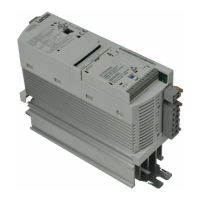Limit value setting
Speed range
10
Function library
10.6
10.6.1
L
10.6-2
EDS82EV903-1.0-11/2002
Relation between output frequency and synchronous speed of the motor:
C0011 ⋅ 60
r
rsyn
Synchronous motor speed [min
-1
]
n
rsyn
=
p
C0011 Max. output frequency [ Hz]
p No. of pole pairs (1, 2, 3, ...)
Example:
4-pole asynchronous motor: p = 2, C0011 = 50 Hz
n
rsyn
=
50 ⋅ 60
2
= 1500 min
−1
”Minimum output frequency” characteristics:
l C0010 is approached via the acceleration ramp.
l C0010 has no effect
– on the analog input 2 of the application I/O.
– when the setpoint is selected via frequency input.
l C0010 ≥ C0011:
– C0011 is approached via the acceleration ramp regardless of the selected
analog setpoint.
– The output frequency is limited to C0011.
– The analog input gain must be set to zero (C0027 = 0), to ensure a
trouble-free operation.
”Maximum output frequency” characteristics:
l When selecting fixed setpoint (JOG) C0011 acts as limitation.
l C0011 is an internal normalisation variable! Bigger changes should only be
made when the controller is inhibited!
(
((
( Stop!
Set C0011 so that the maximum permissible motor speed will not
be exceeded.
Otherwise the motor can be destroyed.
”Lower frequency limitation” characteristics:
l When using standard I/O, C0239 is approached without acceleration ramp
(jolt!). When using application I/O, C0236 can be used to set an
acceleration time for C0239.
l C0239 = 0.00 Hz only allows one direction of rotation.
l For output frequencies > 300 Hz, chopper frequencies < 8 kHz must be
avoided.
l The display values of C0010 and C0011 can be related to a process
variable under C0500 and C0501.
Adjustment
C0010
C0011
C0239
Tip
